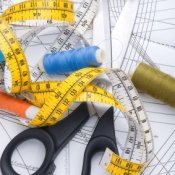 Interfacing can be expensive, but I have found that landscape fabric is the same thing as sew-on, black, light weight interfacing. It comes in different thickness', too. Landscape fabric is made to keep weeds from growing through your garden. It's made to withstand water, weeds, and 4 or more years of everything the environment can throw at it!
Interfacing can be expensive, but I have found that landscape fabric is the same thing as sew-on, black, light weight interfacing. It comes in different thickness', too. Landscape fabric is made to keep weeds from growing through your garden. It's made to withstand water, weeds, and 4 or more years of everything the environment can throw at it!
This page contains the following solutions.
Have a sewing pattern that you use over and over? Apply a fusible interfacing to the pattern and it will last much longer.
You can use iron-on interfacing, which comes in white or black, for mending of items with finer fabrics. The interfacing is so light weight that the mend won't show, as it would with regular bonding materials.
Here are the questions asked by community members. Read on to see the answers provided by the ThriftyFun community.
Can you use dryer sheets for interfacing fabric in sewing?
By Andria King
Interfacing is not expensive to buy and why would you want to substitute dryer sheets? An old dryer sheet might leave a grease stain on your fabric.
The grease from the dryer sheet will gunk up the sewing machine. Not a happy thing to deal with.
You can get interfacing that is sew in stuff, rather than iron on and cut into size you need. I have the heavy stuff and cut some into inch size strips to have handy for things.
Used dryer sheets, of course. Why not? The softening agent isn't grease. If it were, you'd have all kinds of spots on your clean dry cloths. It disperses in the dryer as you dry your wash load so the used sheet should be perfectly fine to use as facing.
Coffee filters are used when you sew lightweight or unstable fabrics. When you're done sewing you tear it away. If used as interfacing it will just wash away.
I would like to know if fusible interfacing is breathable? I am making a bed cover and pillow shams with a woven-acrylic material. It is very breathable, but I need to find the right fabric to put just behind this woven fabric. I am looking for a breathable interfacing/fabric. So I wonder if anyone may have a great suggestion? Thank you!:)
By Cindy
Depends on what type. Heavier weights of it are not, lighter weights are. Seen in ones are if light but the iron on ones are not.
You need to read the label. The people who work in the store can help you. You can also call customer service at Nancys Notions, a company that sells all kinds of sewing and quilting products.
I made a small tee shirt quilt and used Pellon 911FF and the quilt top is stiff. Will washing and drying make it softer?
By Jeanne
Yes, the stiffness will break down.
Need sewing advise. I added Pellon fusible non-woven interfacing to the front and back of an evening bolero jacket (per the pattern instructions) and I do not like the stiffness. Does anyone know how to remove the fused interfacing?
I've been through this & it's not fun... & the truth is, sometimes it's impossible to remove it, but if you want to give it a try, what you do is take a piece of light colored 100% cotton fabric & lay it over the interfacing, then just iron the cotton it until the interfacing underneath it warms up enough to get a corner pulled up, then slowly keep warming up the interfacing & pulling it up while it's warm (or hot)... Depending on how well you've fused it & how long it's been sitting will decide if it will or won't come away from the fabric.
You've probably used an interfacing that was just a wee bit thicker than was needed for that particular fabric. I've done this many times when I've not had the interfacing I needed, but now, I recently stocked up on different kinds when it was 50% off, so hopefully this won't happen to me again. I personally like the knitted interfacing, the one for knits because it moves & bends a little when you do.
Just iron again on the interfacing until it heats up and peel if off. I've not had any trouble doing this before but it is difficult to remove any left over goo. Good Luck!
What is the difference between fusible fleece and fusible interfacing?
Pam from Mt. Morris, MI
Fusible interfacing is generally thinner than the fleece and is used to add weight, stability and durability to a pattern piece. Interfacing is generally used in collars, waistbands and where buttons are so that buttons or the buttonholes don't tear the fabric.
Is there any substitute for fusible fleece that's more economical ?